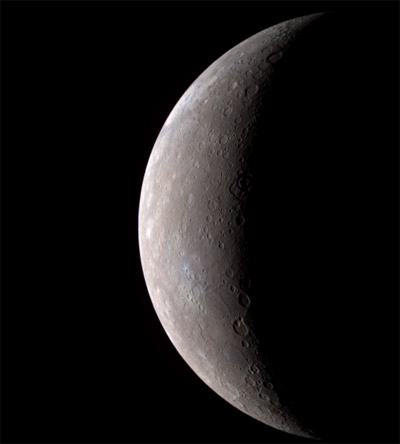 On January 14, NASA’s MESSENGER spacecraft flew past Mercury. MESSENGER — short for MErcury Surface, Space ENvironment, GEochemistry, and Ranging — made the first close-up observations of the innermost planet in 33 years. This flyby marked the first of three encounters with the planet, providing gravity assists necessary to place the probe in orbit around Mercury in March 2011.
On January 14, NASA’s MESSENGER spacecraft flew past Mercury. MESSENGER — short for MErcury Surface, Space ENvironment, GEochemistry, and Ranging — made the first close-up observations of the innermost planet in 33 years. This flyby marked the first of three encounters with the planet, providing gravity assists necessary to place the probe in orbit around Mercury in March 2011.
January 25, 2008
As Mercury fades in the distance, MESSENGER continues along its predetermined path. The innermost planet now lies 2.99 million miles (4.82 million kilometers) in the spacecraft’s rearview mirror. That’s a far cry from closest approach January 14, when the probe skimmed just 125 miles (200 km) above the planet’s surface.
All 500 megabytes of MESSENGER’s observations are now safely on Earth. All seven instruments operated as planned during the flyby, including the Mercury Dual Imaging System (MDIS). As the name implies, MDIS consists of two cameras: one that snaps wide-angle images and one that takes close-up shots. The cameras took 1,213 photos during the flyby.
With 11 narrow-band filters, the Wide Angle Camera can generate color images. The filters span the visible and near-infrared parts of the spectrum. (Compare that with the vidicon camera on Mariner 10 — the first spacecraft to visit Mercury, in the mid-1970s — which possessed just three filters.) Subtle color variations allow scientists to differentiate between minerals and rock types.
The first color image released shows Mercury from a distance of about 17,000 miles (27,000 km) and was taken 80 minutes before the spacecraft’s closest approach. The image combines views through three filters at wavelengths of 1,000, 700, and 430 nanometers (infrared, far red, and violet, respectively). The relatively bright and blue splashes, which stand out from the overall reddish plains, spotlight Mercury’s youngest craters.
Planetary scientists have just started analyzing MESSENGER’s data, and it will take them a while to reach any firm conclusions. NASA has scheduled a press conference for next Wednesday, when team members will discuss preliminary results. I’ll be back then with a first look at MESSENGER science.